Mercury Sable 1997 Owner's Manuals
Manufacturer: MERCURY, Model Year: 1997, Model line: Sable, Model: Mercury Sable 1997Pages: 167, PDF Size: 1.59 MB
Page 121 of 167

CHECKING AND ADDING WASHER FLUID
Check the washer fluid
whenever you stop for
fuel. The reservoir is
highlighted with a
washer symbol.
If the level is low, add enough fluid to fill the
reservoir. In very cold weather, do not fill the
reservoir all the way.
Checking and adding washer fluid for the
liftgate (wagon only)
The opening for the reservoir is located on the
passenger side under the tail lamp. Refill this
reservoir with the same fluid you use for your
windshield.
CHECKING AND ADDING ENGINE COOLANT
Check the level of the
coolant in the reservoir
at least once a month.
Be sure to read and
understand
Precautions when
servicing your vehicle
in this chapter.
If the engine coolant has not been checked for a
long period of time, the engine coolant reservoir may
eventually empty. If this occurs, add engine coolant
dno_wiper-washer
com_checking-adding_coolant.01
Maintenance and care
121
Page 122 of 167
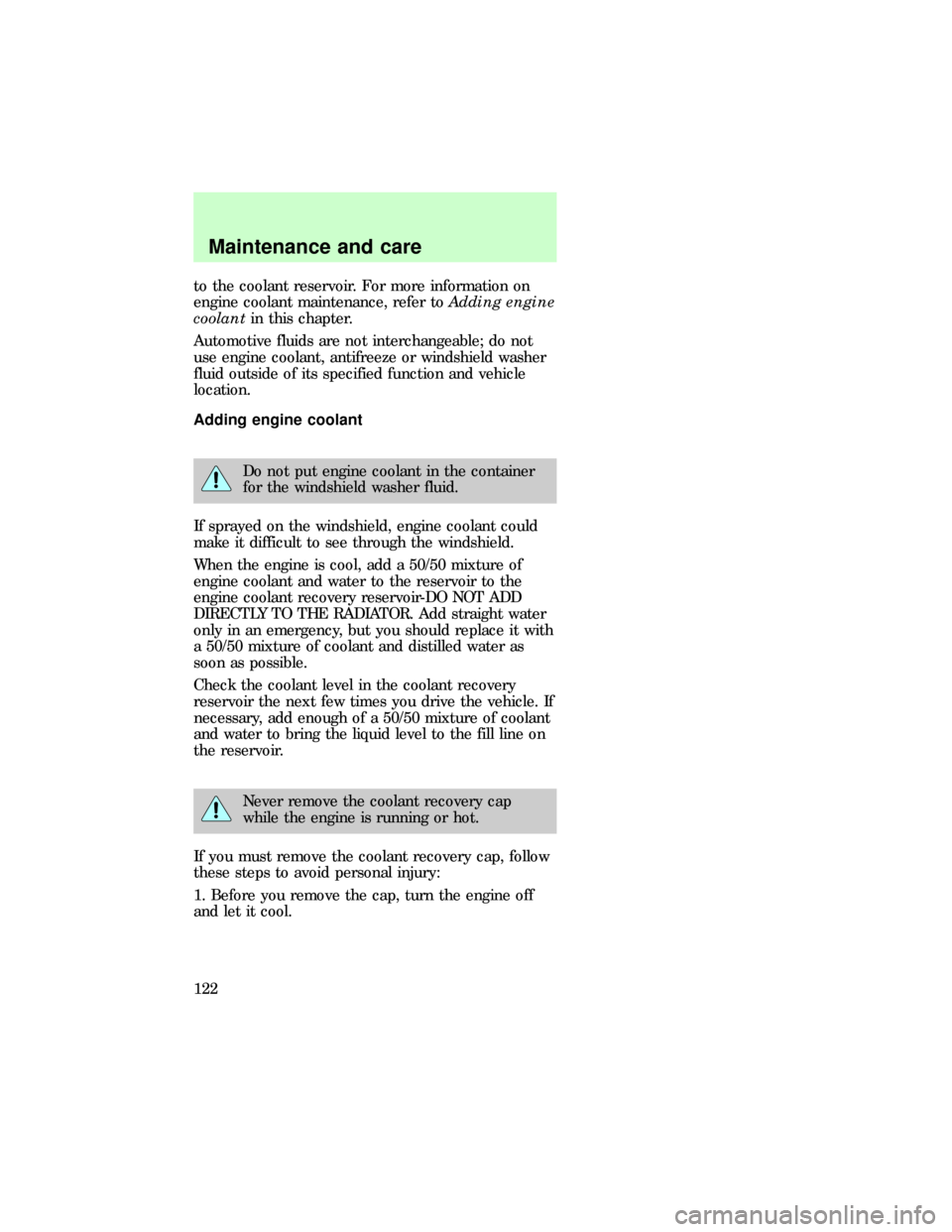
to the coolant reservoir. For more information on
engine coolant maintenance, refer toAdding engine
coolantin this chapter.
Automotive fluids are not interchangeable; do not
use engine coolant, antifreeze or windshield washer
fluid outside of its specified function and vehicle
location.
Adding engine coolant
Do not put engine coolant in the container
for the windshield washer fluid.
If sprayed on the windshield, engine coolant could
make it difficult to see through the windshield.
When the engine is cool, add a 50/50 mixture of
engine coolant and water to the reservoir to the
engine coolant recovery reservoir-DO NOT ADD
DIRECTLY TO THE RADIATOR. Add straight water
only in an emergency, but you should replace it with
a 50/50 mixture of coolant and distilled water as
soon as possible.
Check the coolant level in the coolant recovery
reservoir the next few times you drive the vehicle. If
necessary, add enough of a 50/50 mixture of coolant
and water to bring the liquid level to the fill line on
the reservoir.
Never remove the coolant recovery cap
while the engine is running or hot.
If you must remove the coolant recovery cap, follow
these steps to avoid personal injury:
1. Before you remove the cap, turn the engine off
and let it cool.
dno_adding-coolant
Maintenance and care
122
Page 123 of 167
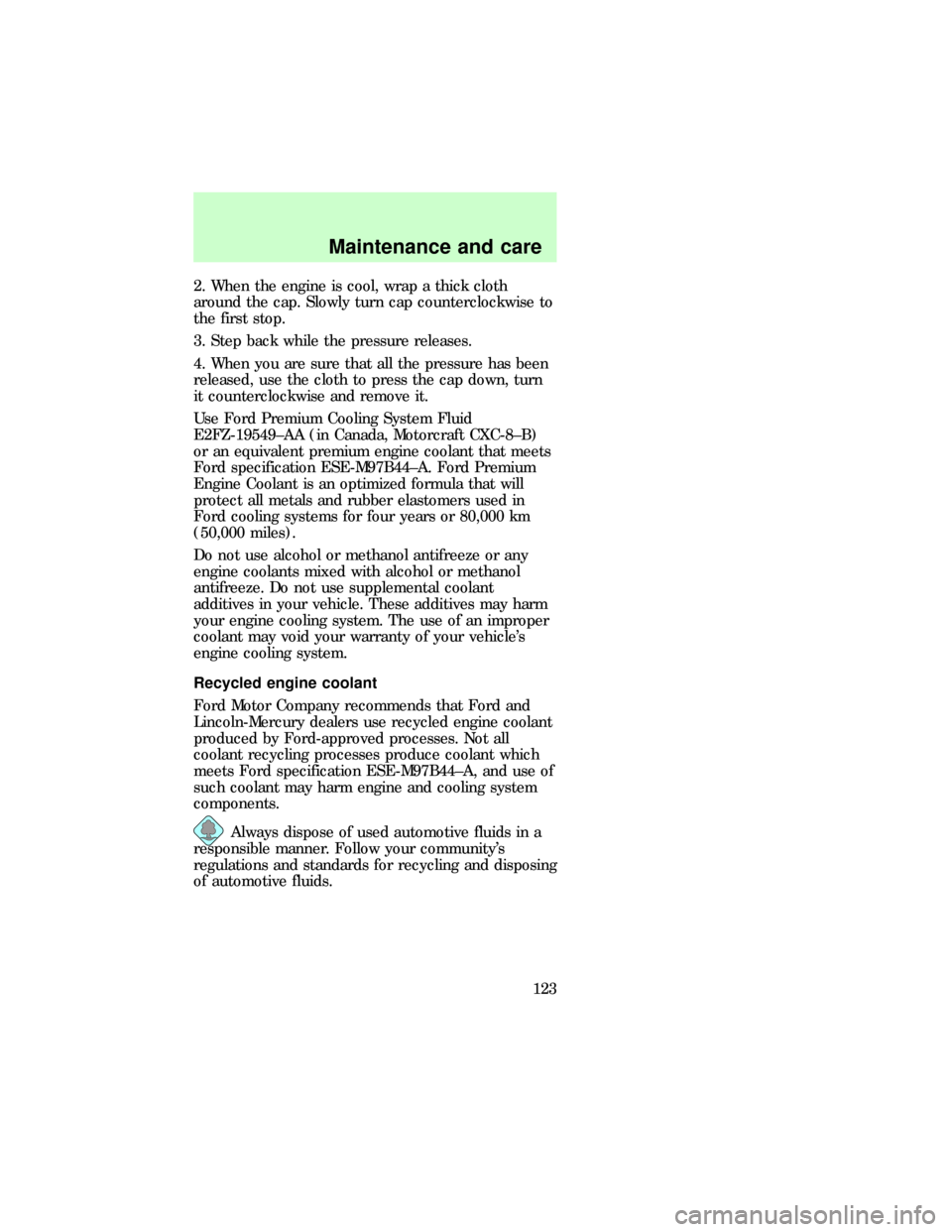
2. When the engine is cool, wrap a thick cloth
around the cap. Slowly turn cap counterclockwise to
the first stop.
3. Step back while the pressure releases.
4. When you are sure that all the pressure has been
released, use the cloth to press the cap down, turn
it counterclockwise and remove it.
Use Ford Premium Cooling System Fluid
E2FZ-19549±AA (in Canada, Motorcraft CXC-8±B)
or an equivalent premium engine coolant that meets
Ford specification ESE-M97B44±A. Ford Premium
Engine Coolant is an optimized formula that will
protect all metals and rubber elastomers used in
Ford cooling systems for four years or 80,000 km
(50,000 miles).
Do not use alcohol or methanol antifreeze or any
engine coolants mixed with alcohol or methanol
antifreeze. Do not use supplemental coolant
additives in your vehicle. These additives may harm
your engine cooling system. The use of an improper
coolant may void your warranty of your vehicle's
engine cooling system.
Recycled engine coolant
Ford Motor Company recommends that Ford and
Lincoln-Mercury dealers use recycled engine coolant
produced by Ford-approved processes. Not all
coolant recycling processes produce coolant which
meets Ford specification ESE-M97B44±A, and use of
such coolant may harm engine and cooling system
components.
Always dispose of used automotive fluids in a
responsible manner. Follow your community's
regulations and standards for recycling and disposing
of automotive fluids.
com_recycled_coolant.01
com_refill_capacity.01
Maintenance and care
123
Page 124 of 167

Coolant refill capacity
To find out how much fluid your vehicle's cooling
system can hold, refer toRefill capacitiesin the
Capacities and specificationschapter.
Have your dealer check the engine cooling system
for leaks if you have to add more than a liter (quart)
of engine coolant per month.
Severe winter climate
If you drive in extremely cold climates [less than
±36ÉC (±34ÉF)], it may be necessary to increase the
coolant concentration above 50%. Refer to the chart
on the coolant container to ensure the coolant
concentration in your vehicle is such that the
coolant will not freeze at the temperature level in
which you drive during winter months. Never
increase the engine coolant concentration above
60%. Leave a 50/50 mixture of engine coolant and
water in your vehicle year-round in non-extreme
climates.
CHECKING AND ADDING POWER STEERING
FLUID
Check the power
steering fluid at least
twice a year. If adding
fluid is necessary, use
only MercontAT F
power steering fluid.
1. Start the engine and let it run until it reaches
normal operating temperature (the engine coolant
gauge will be near the center of the NORMAL band).
2. While the engine idles, turn the steering wheel
left and right several times.
com_winter_climate.01
dno_power-steering-fluid
Maintenance and care
124
Page 125 of 167
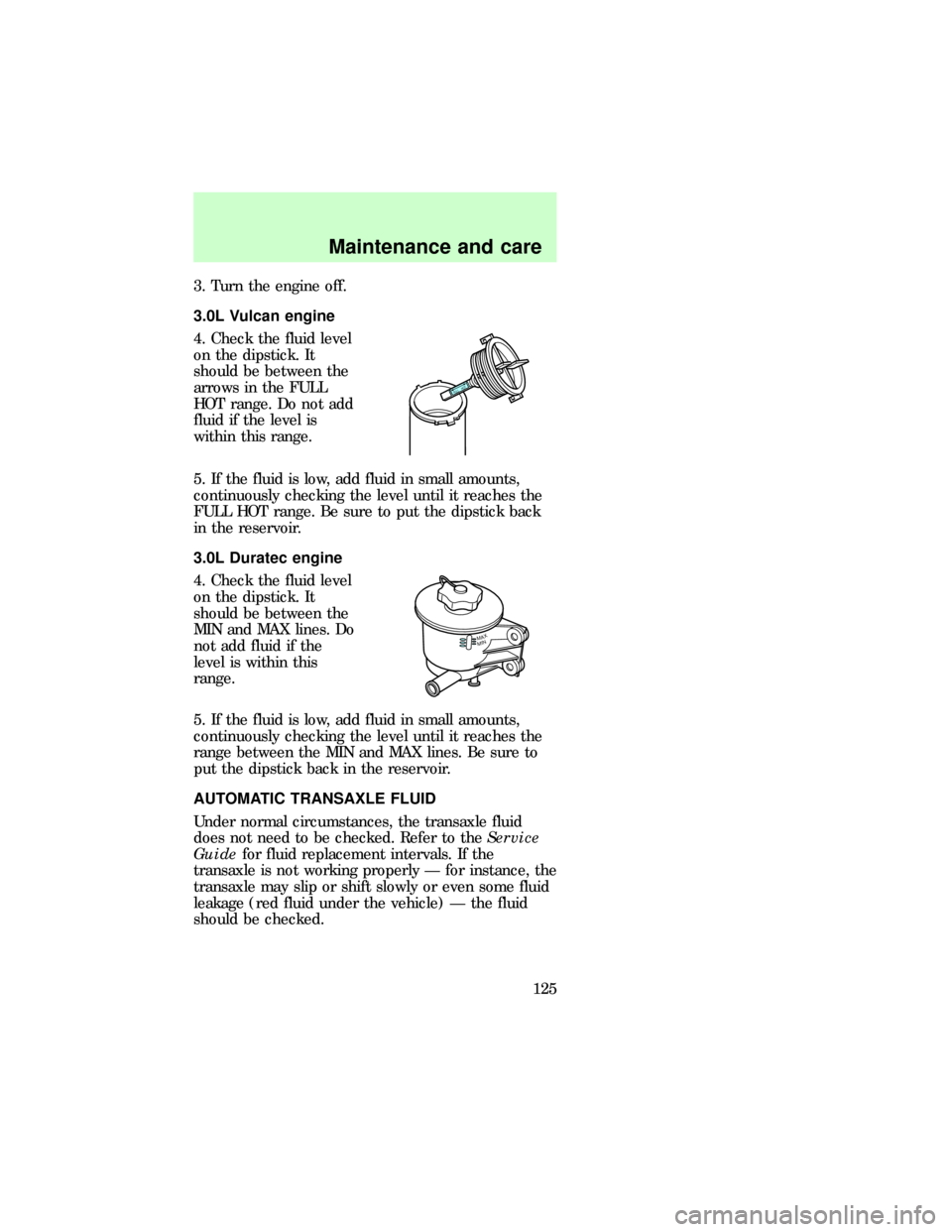
3. Turn the engine off.
3.0L Vulcan engine
4. Check the fluid level
on the dipstick. It
should be between the
arrows in the FULL
HOT range. Do not add
fluid if the level is
within this range.
5. If the fluid is low, add fluid in small amounts,
continuously checking the level until it reaches the
FULL HOT range. Be sure to put the dipstick back
in the reservoir.
3.0L Duratec engine
4. Check the fluid level
on the dipstick. It
should be between the
MIN and MAX lines. Do
not add fluid if the
level is within this
range.
5. If the fluid is low, add fluid in small amounts,
continuously checking the level until it reaches the
range between the MIN and MAX lines. Be sure to
put the dipstick back in the reservoir.
AUTOMATIC TRANSAXLE FLUID
Under normal circumstances, the transaxle fluid
does not need to be checked. Refer to theService
Guidefor fluid replacement intervals. If the
transaxle is not working properly Ð for instance, the
transaxle may slip or shift slowly or even some fluid
leakage (red fluid under the vehicle) Ð the fluid
should be checked.
FULL HOT
MINMAX
dno_steers
sab_steer
dno_transaxle-fluids
dno_checking-trans
Maintenance and care
125
Page 126 of 167
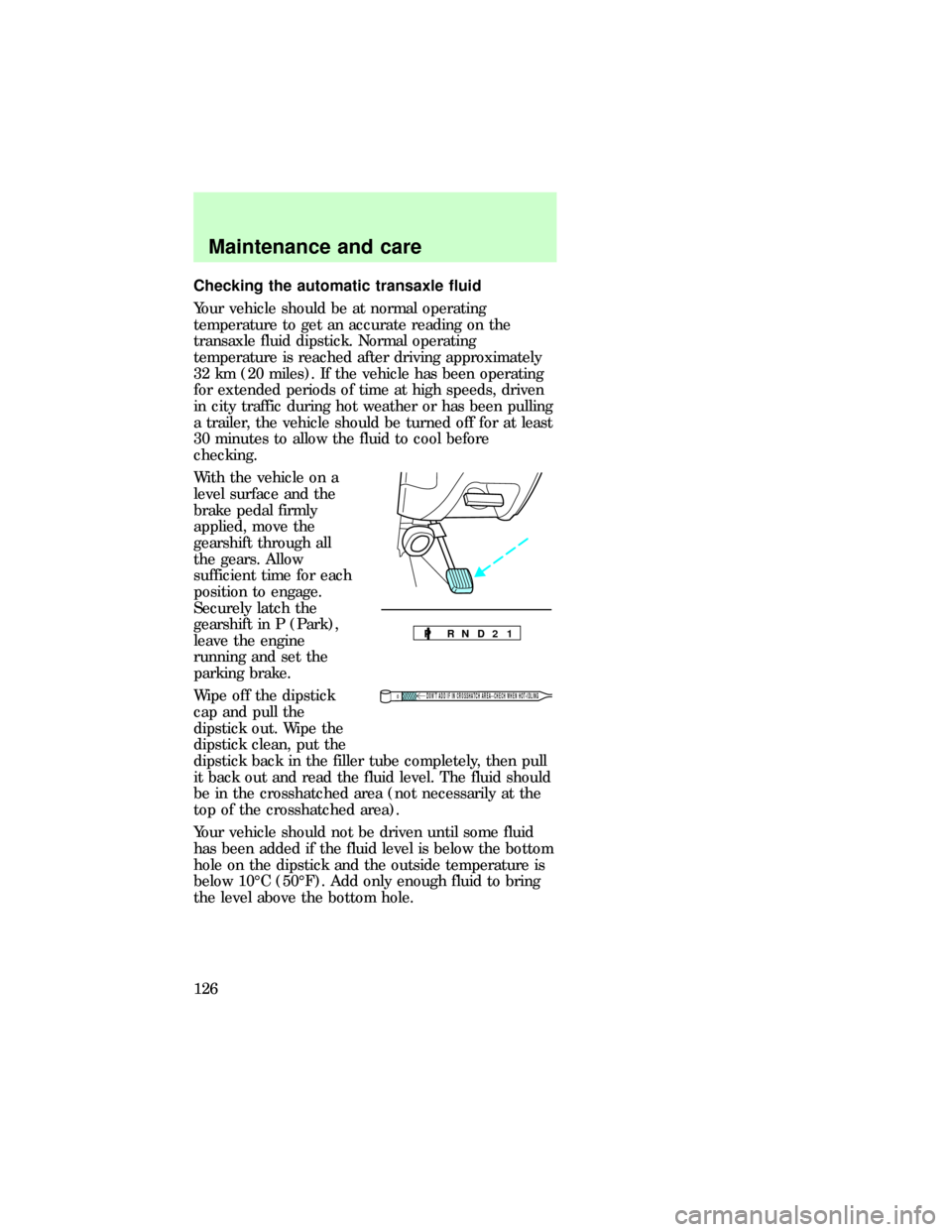
Checking the automatic transaxle fluid
Your vehicle should be at normal operating
temperature to get an accurate reading on the
transaxle fluid dipstick. Normal operating
temperature is reached after driving approximately
32 km (20 miles). If the vehicle has been operating
for extended periods of time at high speeds, driven
in city traffic during hot weather or has been pulling
a trailer, the vehicle should be turned off for at least
30 minutes to allow the fluid to cool before
checking.
With the vehicle on a
level surface and the
brake pedal firmly
applied, move the
gearshift through all
the gears. Allow
sufficient time for each
position to engage.
Securely latch the
gearshift in P (Park),
leave the engine
running and set the
parking brake.
Wipe off the dipstick
cap and pull the
dipstick out. Wipe the
dipstick clean, put the
dipstick back in the filler tube completely, then pull
it back out and read the fluid level. The fluid should
be in the crosshatched area (not necessarily at the
top of the crosshatched area).
Your vehicle should not be driven until some fluid
has been added if the fluid level is below the bottom
hole on the dipstick and the outside temperature is
below 10ÉC (50ÉF). Add only enough fluid to bring
the level above the bottom hole.
P R N D 2 1
DON’T ADD IF IN CROSSHATCH AREA--CHECH WHEN HOT-IDLING
dno_adding-fluid
Maintenance and care
126
Page 127 of 167
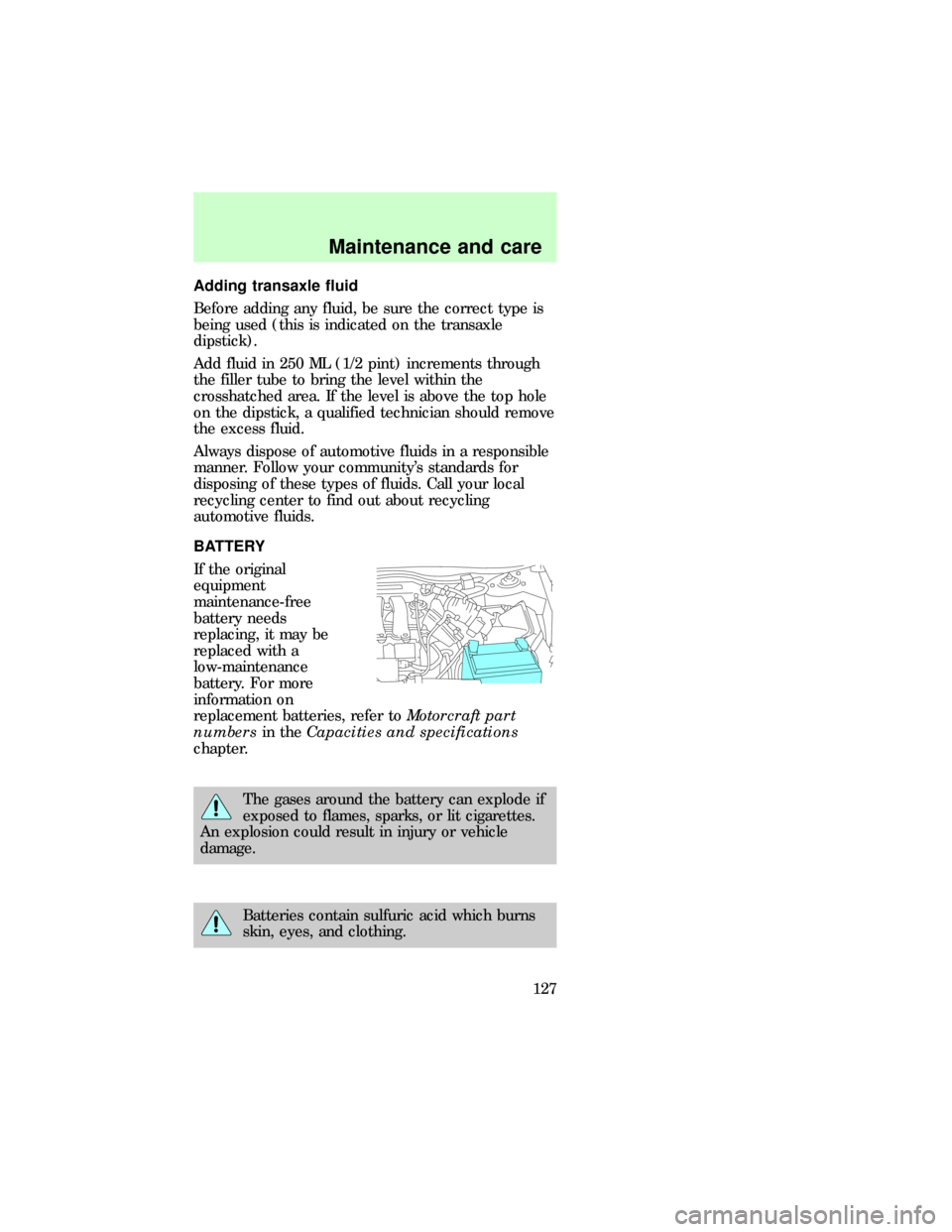
Adding transaxle fluid
Before adding any fluid, be sure the correct type is
being used (this is indicated on the transaxle
dipstick).
Add fluid in 250 ML (1/2 pint) increments through
the filler tube to bring the level within the
crosshatched area. If the level is above the top hole
on the dipstick, a qualified technician should remove
the excess fluid.
Always dispose of automotive fluids in a responsible
manner. Follow your community's standards for
disposing of these types of fluids. Call your local
recycling center to find out about recycling
automotive fluids.
BATTERY
If the original
equipment
maintenance-free
battery needs
replacing, it may be
replaced with a
low-maintenance
battery. For more
information on
replacement batteries, refer toMotorcraft part
numbersin theCapacities and specifications
chapter.
The gases around the battery can explode if
exposed to flames, sparks, or lit cigarettes.
An explosion could result in injury or vehicle
damage.
Batteries contain sulfuric acid which burns
skin, eyes, and clothing.
dno_battery
Maintenance and care
127
Page 128 of 167

Applying too much pressure on the ends
when lifting a battery could cause acid to
spill. Lift the battery with a carrier or with your
hands on the opposite corners.
Servicing your battery
The low-maintenance battery has removable vent
caps for checking electrolyte level and adding water.
Check electrolyte level every 24 months or 40,000
km (24,000 miles) in an average temperature of
32ÉC (90ÉF). Keep the electrolyte level in each cell
up to the level indicator. Do not overfill.
If the level gets low, refill the battery with distilled
water. If necessary, distilled water may be
substituted with tap water that is not hard or has a
high mineral or alkali content. If the battery needs
water quite often, have the charging system checked
for a possible malfunction.
Because your vehicle's engine is electronically
controlled by a computer, some control conditions
are maintained by power from the battery. When the
battery is disconnected or a new battery is installed,
the engine must relearn its idle conditions before
you vehicle will drive properly. To begin this process:
1. Put the gearshift in P (Park), turn off all
accessories and start the vehicle.
2. Let the engine idle for at least one minute.
3. The relearning process will automatically
complete as you drive the vehicle.
²If you do not allow the engine to relearn its idle,
the idle quality of your vehicle may be adversely
affected until the idle is eventually relearned.
²If the battery has been disconnected or a new
battery has been installed, the clock and the
preset radio stations must be reset once the
battery is reconnected.
Maintenance and care
128
Page 129 of 167

²Always dispose of automotive batteries in a
responsible manner. Follow your communities
standards for disposal. Call your local recycling
center to find out more about recycling
automotive batteries.
CHANGING YOUR AIR FILTER
To replace your air
filter, unclip the two
latches, separate the
housing and remove
the old filter. Wipe the
interior clean before
inserting new air filter.
Lock the two latches.
Do not use oil-impregnated air filters. Filters other
than the ones specified in this owner guide can
cause serious damage. Your warranties may not
apply if your vehicle is damaged because you use
the wrong air filter. Refer toMotorcraft part
numbersin theCapacities and specifications
chapter.
CHECKING AND CHANGING WIPER BLADES
Check the wiper blades at least twice a year or when
they seem less effective than usual. Substances such
as tree sap and some hot wax treatments used by
commercial car washes reduce the effectiveness of
wiper blades.
Checking the wiper blades
If the wiper blades do not clean properly, clean the
windshield and wipers. Use an undiluted windshield
washer solution or a mild detergent, then rinse
thoroughly with clear water. Do not use fuel,
kerosene, paint thinner or other solvents to clean
dno_changing-air-filter
dno_wipers
dno_check-wipers
Maintenance and care
129
Page 130 of 167

the wiper blades as these will damage the blades.
Changing the wiper blades
When replacing wiper blades assemblies, always use
a Motorcraft part or equivalent. To replace the
blades, follow the instructions on that come with the
new wipers. To make reaching the wipers easy, turn
the ignition to the ACC position, then turn the
wipers on. When the wipers reach the vertical
position, turn the ignition OFF.
INFORMATION ABOUT TIRE QUALITY GRADES
New vehicles are fitted
with tires that have
their Tire Quality
Grade (described
below) molded into the
tire's sidewall. These
Tire Quality Grades are
determined by
standards that the
United States Department of Transportation has set.
Tire Quality Grades apply to new pneumatic tires for
use on passenger cars. They do not apply to deep
tread, winter-type snow tires, space-saver or
temporary use spare tires, tires with nominal rim
diameters of 10 to 12 inches or limited production
tires as defined in Title 49 Code of Federal
Regulations Part 575.104(c)(2).
U.S. Department of Transportation-Tire quality
grades:The U.S. Department of Transportation
requires Ford to give you the following information
about tire grades exactly as the government has
written it.
Treadwear
The treadwear grade is a comparative rating based
on the wear rate of the tire when tested under
controlled conditions on a specified government test
course. For example, a tire grade 150 would weardno_changing-blades
dno_tire-grades
com_about_tire_grades.01
com_treadwear.01
Maintenance and care
130